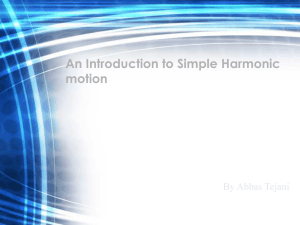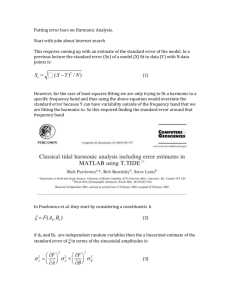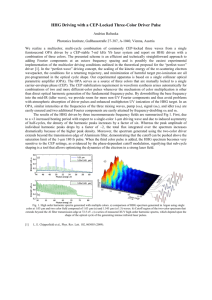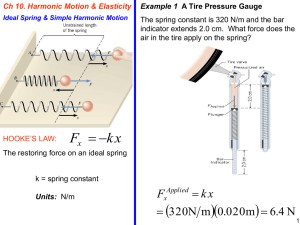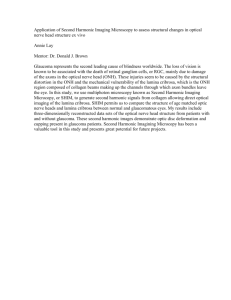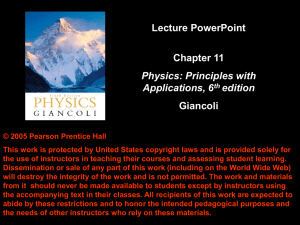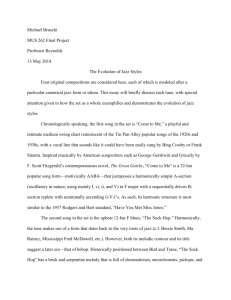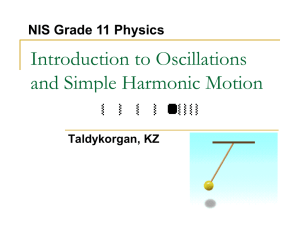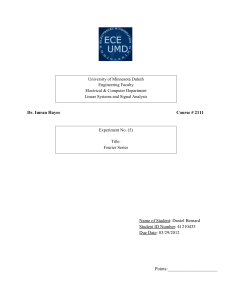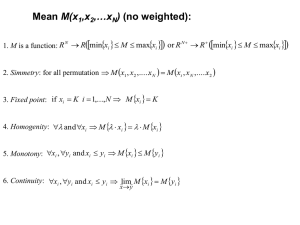ME495_Chapter4_Lecture4
advertisement
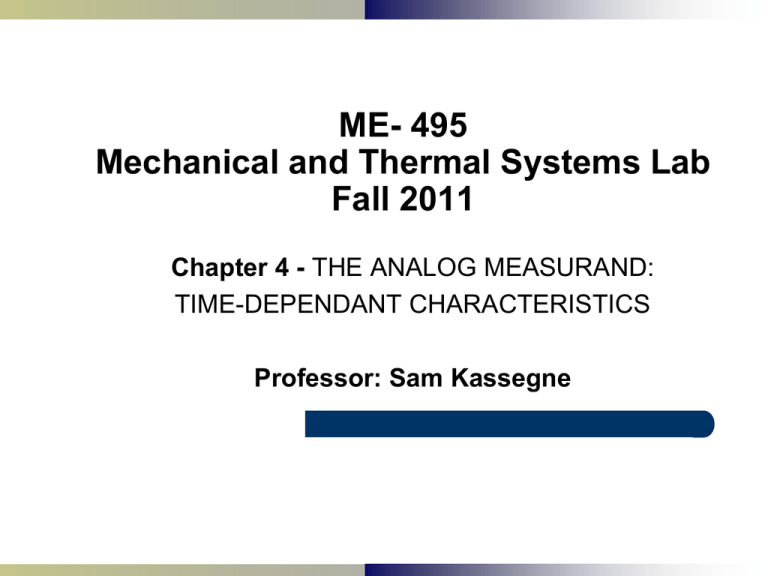
ME- 495 Mechanical and Thermal Systems Lab Fall 2011 Chapter 4 - THE ANALOG MEASURAND: TIME-DEPENDANT CHARACTERISTICS Professor: Sam Kassegne THE ANALOG MEASURAND: TIME-DEPENDANT CHARACTERISTICS Two types of measurement Static – constant over time – Dynamic – varies over time – state – periodic over time Non-repetitive or Transient Steady – – Single Pulse – aperiodic Continuing or random SIMPLE HARMONIC RELATIONS S = Sosin(t) – – – Velocity = ds/dt = So cos(t) – S = instantaneous displacement from equilibrium So = amplitude (maximum displacement) = circular frequency (rad/s) Vo = So Acceleration = dV/dt = - So 2 sin(t) – ao = - So 2 Exercise: Give some practical examples of such a motion. CIRCULAR & CYCLIC FREQUENCY 1Hz (hertz) = 1 cycle/second f = cyclic frequency (Hz) = circular frequency = 2f S = Sosin(2ft) Scotch-yoke mechanism – Harmonic motion COMPLEX RELATIONS Most complex dynamic mechanical signals, steady-state or transient (such as pressure, displacement, or strain) may be expressed as a combination of simple harmonic components. Ao y(t ) An cosnt Bn sin nt 2 n1 – – Ao, An, Bn = amplitude determining constants called harmonic constants. n = integers from 1 to called “harmonic orders” The above equation is also called Fourier Series. Example: A 2-harmonic term pressure-time function. P = 100 sin 80t + 50 cos (160t-/4) The circular frequency of the fundamental harmonic = 80 rad/sec or 80/2 = 12.7 Hz. The period = 1/12.7 = 0.0788 sec The circular frequency of the second harmonic = 160rad/sec or 160/2p = 25.4 Hz. The period = 1/25.4 = 0.039 sec It also lags the fundamental by 1/8th cycle (/4) FREQUENCY SPECTRUM Type of plot where frequency (instead of time) is the independent variable and amplitude is the ordinate. Special Wave-forms. (infinite series) FREQUENCY SPECTRUM (ctd.) Frequency spectrum is useful because it allows identifying – at a glance – the frequencies present in a signal (say natural frequencies). Interest in FS plots increased because of spectrum analyzers. Two ways to perform a spectrum analysis Spectrum Analyzers electronic device which displays frequency spectrum on CRT using circuitry Fast Fourier Transform computer algorithm that computes spectrum Harmonic or Fourier Analysis The process of determining the frequency spectrum of a known waveform is called harmonic analysis, or Fourier analysis. The case where y(t) is known only at discrete points in time is important is practice because of wide use of computers for recording signals. DISCREET FOURIER TRANSFORM N = total points recorded T = time period t = time interval n = harmonic order r = sample count = 1,2,3,…N DISCREET FOURIER TRANSFORM (ctd) If one assumes that one’s experimental data can be expressed as cosine/sine function (say y = cos(-x+phi); y = sin (x+phi1), etc), the harmonic analysis then becomes a problem of determining appropriate values for harmonic orders (n), coefficients and phase angles. • The process starts with an analog time dependent signal which is then digitized by selecting discrete values at predetermined time intervals. • These values are then processed by harmonic analysis through which frequency contribution and relative amplitudes are determined. • This provides a composite functional relationship that defines the original relationship (Equation in previous slide). EXAMPLE OF DFT ANALYSIS 3 signals: 500, 1000, 1500 Same amplitude: 50 mV Out of phase with each other Sample rate fs = 9000Hz N = 18 flowest = 500 Hz therefore T = 1/fL=0.002sec and t= 1/fs t=0.11ms Harmonic orders evaluated: n=N/2=9 Cn A n B n 2 2 Method for calculating the Harmonic constants using Excel Spreadsheet EXAMPLE OF DFT ANALYSIS (ctd.)

